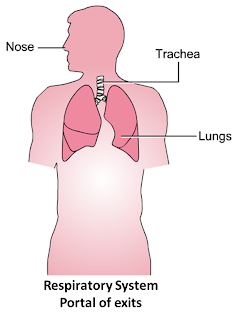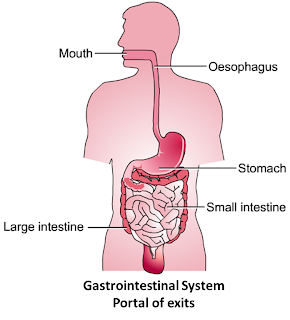The basic
components of bacterial cells are:-
- Cell wall
- Plasma membrane
- Cytoplasm
- Chromosome
- Ribosome
The outer most structure of bacteria is the cell wall a semi
rigid envelope that maintains the integrity of the cell in the same way that
the skin maintains the integrity of the human body.
The cell wall helps protect the cell against environmental changes
for example heat, cold and drugs that would otherwise damage or destroy it.
It allows most molecules to pass through it. This layer is composed
of molecules called Peptidoglycans; this is often called Peptidoglycans
layer.
Just inside the cell wall is a second less rigid envelope the plasma
membrane sometimes called the inner membrane or cytoplasmic membrane
which encloses the cell contents; in bacterial cells the plasma membrane has
two primary functions:-
First it serves as a selective barrier to molecules that penetrating the
cell wall; allowing some - such as water or oxygen - to flow easily into the
cell enteria and restricting the passage of another such as proteins.
Second it contains enzymes; proteins that
cause chemical reactions to occur as vital to the life functions of the cell.
Bacteria can be divided into two main groups based on differences
in the cell walls structure; this difference was first noticed as differences
in staining with a dye called gram’s stain.
Gram positive organisms have the
structure defined so far.
But Gram negative bacteria have an additional membrane outside
the peptidoglycans layer called the outer membrane; this which contains
openings called channels some them formed by protein called Porins
which allows nutrients, waste products, fluids to flow into and out of the cell.
Some of these channels are non-specific they allow any
molecule up to certain size to flow through them; other channels are specific;
only certain particular molecules can pass through them while prohibiting the
entry of other molecules including antibiotic drugs into the cell; the cell
wall channels protect the cell contents and enhance the likelihood of the cells
of survival.
Cytoplasm is a viscid, thick, sticky substance that serves as the matrix
fully interior contents of the cell; cytoplasm is made up primarily of water
accounting for eighty percent of the total content; it also contains enzymes
and nutrients such as carbohydrates, lipids, fats and other molecules.
In most bacteria the genetic material is contained in one single
circular chromosome and contains all hereditary information required for
bacteria; the chromosome consists of genes which made up of deoxyribonucleic
acid (DNA)
DNA is a material that is composed of long and twisted strands of
compounds called nucleotides arranged in a double helix pattern; DNA
Carries the codes of reproducing specific proteins which determine
characteristics or functions of the organism; in the higher organisms such as
humans and plants chromosomes are enclosed in the cell nucleus;
therefore these organisms are called eukaryotes; in contrast bacterial
cells are prokaryotes since they lack of cell nucleus in addition to the
existence of a single chromosome.
In addition to single chromosome; many bacterial cells it contains
circular molecules of DNA called plasmid; it may carry genes the codes
helps for resistance to antibiotics and for production of toxins both of which
are important to bacterial survival; however the DNA contained in the plasmid is
not for reproduction or other of basic cell function.
There are more than one type of ribonucleic acid RNA;
ribosomal RNA and other proteins complex to form the ribosome; ribosomes
are structured to serve as protein factories for the cell; because the cell
cannot survive without proteins; ribosomes are vital to cell life like DNA; RNA
is a component of all living cells and is composed of nucleotides and arranged
in long strands that unlike the double stranded DNA; RNA is a single strand of nucleic
acid and the primary function of RNA is the protein synthesis; the genetic code
contained in the DNA is transcribed into messenger RNA which then travels to
the ribosomes; the genetic code is then
translated into proteins.






























